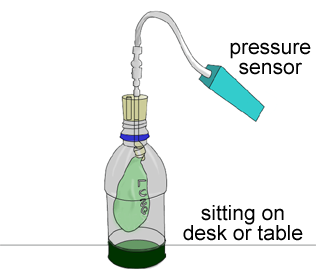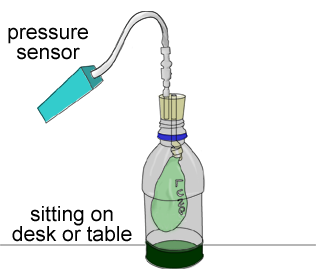 | ||
| || home ||| units ||||| help | ||
| All Units | > | Unit 11 - Air pressure | > | Investigation 2 - Air pressure and the lungs | > | Trial 2 |
Trial 2 - How do you inhale and exhale?
-
Take a deep breath, using your diaphragm.

When you inhale, what happens to your diaphragm?

-
What do you think happens to the shape of your lungs when you take a deep breath using your diaphragm?

-
Now we will investigate using your model. What happens to the "lung" in the model when you pull the "diaphragm" down? Why do you think this happens?

-
Now let's look at why this is happening. Without touching the "diaphragm" on your model, measure the air pressure in the balloon or "lung". You can do this by connecting the pressure sensor to the hole on the stopper that the balloon is connected to as shown below. Refer to Technical Hints to connect the air pressure sensor. Refer to Technical Hints to record a single measurement.

Pressure in the balloon or "lung":
-
Now connect the pressure sensor to the other hole in the stopper to measure the pressure in the "chest cavity". Refer to Technical Hints to record a single measurement.

Pressure in the "chest cavity":
-
Label the picture below with the pressure in the "lung" and the pressure in the "chest cavity". Refer to Technical Hints to use the drawing tool.

-
Measure the pressure inside the bottle (chest cavity) as you pull down on the "diaphragm" balloon, hold it down for a few seconds, and then slowly release it. Refer to Technical Hints to record a series of measurements.

-
Repeat your data collection at least three times to make sure your results are consistent.
-
When you pull the "diaphragm" down, the size or volume of the chest cavity increases. Label on your line graph where you pulled the "diaphragm" down (inhaled). Refer to Technical Hints to label a graph.
-
What happens to the air pressure in the "chest cavity" when the volume of the "chest cavity" increases?
When volume increases air pressure decreases. When volume increases air pressure increases. When volume increases air pressure stays the same.
-
Label the picture below with the pressure in the "lung" and the pressure in the "chest cavity", this time using the lowest pressure you recorded on your graph above. Refer to Technical Hints to use the drawing tool.

-
Using what you understand about air pressure, use words and/or drawings to explain why the balloon inflates. Refer to Technical Hints to use the drawing tool. Be prepared to share your explanation with the class.


-
If you wanted the "lung" balloon to blow up even more, what would you need to do to the pressure in the "chest cavity"?
Raise it. Lower it further. Explain.

 |  |  |
Copyright 2005 The Concord Consortium, All rights reserved.